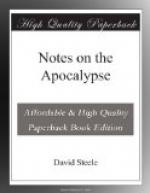THE LITTLE BOOK.
This symbol is in the tenth chapter evidently distinguished from the one in the fifth chapter. It is considered by several interpreters as containing all that follows to the end of the book. According to this view, it would be larger than the sealed book, (ch. v. 1.) Such a view is altogether untenable, involving, as it does, almost a palpable contradiction. The little book is indeed comprehended in the sealed book, as a part of the whole; or it may be viewed as an appendix or codicil, or perhaps still more correctly as a parenthesis, interrupting the series of the trumpets, that the object of the seventh or last woe-trumpet maybe thus described and rendered intelligible when sounded.
Mr. Faber is correct in saying, “the eleventh, twelfth, thirteenth and fourteenth chapters, in point of chronology run parallel to each other;” but he is mistaken when he says the “little book comprehends these four chapters.” It comprehends only so much as intervenes between the close of the ninth chapter and the fifteenth verse of the eleventh chapter; or, in other words, between the sounding of the sixth and seventh trumpet. To be more correct and explicit,—the tenth chapter introduces the little book, and the eleventh chapter, from the first to the fourteenth verse inclusive, exhibits an abstract of its contents,—a condensed narrative or mere outline of the contest during the 1260 years.
THE DEATH OF THE WITNESSES.
Many divines have considered the death of the two witnesses, as consisting in a moral slaying, equivalent to apostacy. Mr. Faber views their life and death as altogether political. He censures Mr. Galloway for “want of strict adherence to unity of symbolical interpretation,” but he inadvertently falls into the same error. Assuming, as he does, that the two witnesses are the Old and New Testament Churches, where is the “unity of symbolical interpretation” when he tells us that the witnesses were politically slain in the “disastrous battle of Mulburgh in the year 1547, by the total route of the protestants under the lead of the Elector of Saxony and the Landgrave of Hesse?” The political death of two churches in the battle of Mulburgh!—Such language exemplifies neither the accuracy of historic narrative, nor the “unity of symbolical interpretation:” nor does it accord with another rule of the writer, one of his three cardinal rules, namely,—That “no interpretation of a prophecy is valid, except the prophecy agree in every particular with the event to which it is supposed to relate.” Mistaking the character of the witnesses, as one of the primary symbols in the Apocalypse, he is unable to ascertain in history either their identity or work, their life or their death. Having imagined their political death in 1547, he supposes their resurrection to political life in 1550,—“by the




